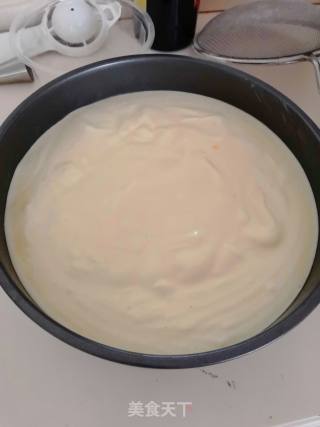Chiffon Cake
1.
Prepare the materials, first weigh the materials and put them away, so you won't be rushing in the process of making them. The caster sugar can be divided into two portions, one portion is 30g with egg yolk, and one portion is 20g with egg white.
2.
Separate the yolk and egg whites and put them in two containers. Note that the egg yolk should not be mixed into the egg white, otherwise it will not be passed. And the container must be oil-free and water-free.
3.
Pour 30g of fine sugar into the egg yolk. I like to beat the egg whites at the end, it won't defoam.
4.
Use a whisk until the sugar is completely incorporated into the egg yolks.
5.
Pour the milk.
6.
Stir the same until the milk is fully incorporated.
7.
Add vegetable oil and stir to fuse. Use odorless vegetable oil. I use olive oil, salad oil or corn oil. Using peanut oil, rapeseed oil and other flavored oils will make the cake taste strange.
8.
Sift in the flour evenly.
9.
Use a rubber spatula to gently stir and mix until there are no gnocchi, otherwise there will be lumps in the cake you can see.
10.
Next, let the egg whites go. Again, the container must be oil-free and water-free, and egg yolk must not be mixed in the egg white, otherwise it cannot be sent.
11.
The electric whisk in 2nd gear beats until the egg whites are in the shape of fish bubbles. Add 1/3 of the remaining 20g granulated sugar.
12.
Continue to beat until it becomes more delicate, then add 1/3 fine sugar.
13.
Beat the 4th gear until there are lines, and then add the remaining 1/3 of the caster sugar.
14.
Just hit the 5th gear to the dry foaming state.
15.
Add the egg whites to the egg yolk paste and mix well. I always like to add the egg whites in three batches. It is better to stir.
16.
After stirring, pour into the mold and vigorously shake out large bubbles. Preheat the oven at 180 degrees, top the heat at 150, lower the heat at 145, and bake for 50 minutes. (The specific temperature and time depends on the temper of your own oven) Each oven has a temperature difference, depending on the situation, you can control the temperature by baking a few more times.


17.
After the test is completed, immediately buckle upside down and let it cool to prevent retraction and collapse. This is the third time I bake. The first time the egg whites were not beaten, and the temperature was wrong, which caused the cake to become a biscuit. For the second time, I followed the steps strictly, and I mastered the heat. It was very successful. My baby usually doesn't like cakes, butter, and these sweets, so I put less sugar, and the child will directly support it after making it. While holding the mold to eat, the child's father was greedy (the second time the child's father was not at home), and this time I made it for him.